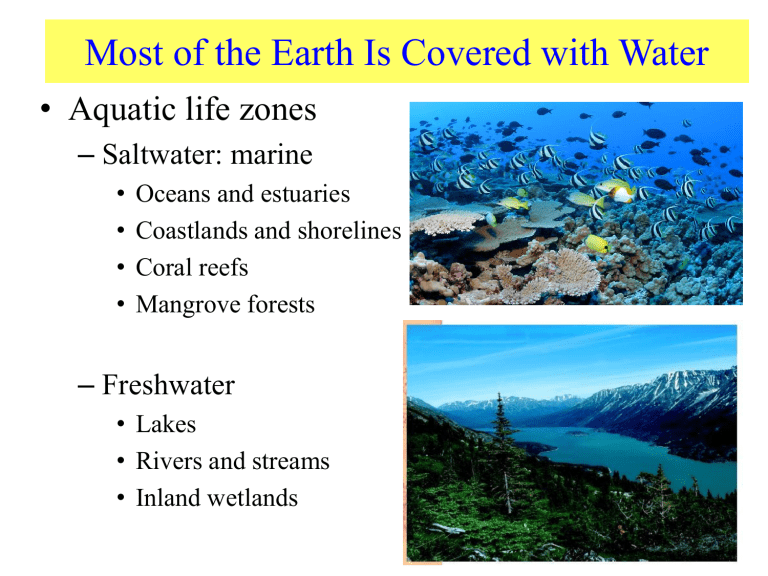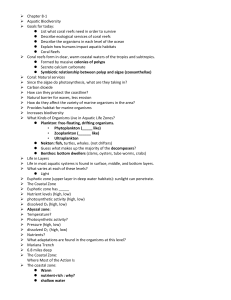Aquatic Systems - Chipley High School Biology Department

Most of the Earth Is Covered with Water
• Aquatic life zones
– Saltwater: marine
• Oceans and estuaries
• Coastlands and shorelines
• Coral reefs
• Mangrove forests
– Freshwater
• Lakes
• Rivers and streams
• Inland wetlands
Two Major types of Aquatic Zones
• The world ’ s salt water and freshwater aquatic system accounts for 71% of the earth ’ s surface.
• Scarcity of Water
But Not a Drop to Drink
2
Aquatic Ecosystems
• Aquatic ecosystems are defined by their salinity, chemistry, geography, depth, flow, light conditions, and water temperature.
• The two main types of aquatic ecosystems are marine ecosystems and freshwater ecosystems
• Each ecosystem has its own properties and organisms.
How much water is there?
Marine and freshwater biomes contain many different types of habitats, from forest bogs to abyssal zones in the deep oceans.
Freshwater Communities
ponds and lakes
• Littoral zone are shallow zones near the shoreaquatic plants live along various predatory insects, amphibians and small fish.
• Limnetic zone refers to the area farthest away from shore but at the surfacefloating algae, zooplankton and fish
• Profundal zone is a deep-water zone that is below the limits of effective light penetrationbacteria and worm-like organisms eat debris on lakes bottom
• Flowing-water ecosystems- Rivers and streams:
organisms are adapted to seasonal change in water levels and rate of flow. Many have adaptations that help them avoid being washed downstream.
• Wetland communities
- swamps, marshes, bogs, and other communitiesvery productive
Marsh
Wetland communities
Bogs in
Wetlands
Tundra
Salinity
• Seawater contains a variety of dissolved solids
– Solutes
• Salinity is measured:
– Conductivity of Cl -
– Refractometer
How Salinity Affects Marine Organisms
• Most marine animals are adapted to a narrow salinity range
• Changes is salinity affect organisms through osmosis
• Hypertonic: water will flow into it across a semipermeable membrane
• Hypotonic : water will leave the solution
12
Varying salinities determine the distribution and abundance of aquatic organisms around the world
How pH Affects Marine Organisms
pH is one of the stable measurements in seawater. Ocean water has an excellent buffering system with the interaction of carbon dioxide and water so that it is generally always at a pH of 7.5 to 8.5.
• Shallow Ocean Water communitiessmall area but it is inhabited by a large number of species.
• Fish are sensitive to changes in pH and would experience a decrease in numbers if a shift in the pH of the water occurred.
– Intertidal - adapted to change in temperature, salinity and exposure to air during the tidal changes. Adapted to cling to rocks
– Coral reef communitymost diverse occurs in shallow tropic waters
– Coastal zones of cooler waters – the world ’ s greatest fisheries
Estuaries and Coastal Wetlands Are
Highly Productive
• Important ecological and economic services
– Coastal aquatic systems maintain water quality by filtering
• Toxic pollutants
• Excess plant nutrients
• Sediments
– Absorb other pollutants
– Provide food, timber, fuelwood, and habitats
– Reduce storm damage and coast erosion
Coastal Zone
• The coastal zone makes up less than 10% of the world ’ s ocean but contains 90% of all marine species.
• Warm, nutrient rich, shallow water
• Extends from high tide mark to edge of the continental shelf
• High productivity because of ample sunlight and plant nutrients flowing from the land
Coastal Ecosystems
• Estuaries - where the river meets the sea.
– Temperature and salinity levels vary greatly
• daily rhythms of the tides
• seasonal variations in the flow of freshwater
• Coastal wetlands lands covered with water all or part of the year
– River mouths, inlets, bays, sounds, mangroves and saltwater marshes
• Mangrove Swamps trees that can tolerate salt
– Extensive roots that stabilize the substrate
– Provides a nursery grounds for many invertebrates and fish
Coral reefs
Mangroves
Reefs , and Mangroves
20
Communities at the surface of the
Open Sea
• Diverse community of plankton
(bacteria, algae, fish larvae, and small invertebrates)
• Phytoplankton are primary producers that rely on the sun to carry out photosynthesis.
• Zooplankton are a major source of food for small and large marine organisms
22
The Great Plankton Race!
The Secret Life of
Plankton
Diatom
Open Ocean
• Water beyond the continental shelf
• Light zones: Euphotic, Disphotic, Aphotic
• Depth Zones: epipelagic, mesopelagic, bathypelagic, abyssolpelagic, hadalpelagic
• Average primary productivity and NPP per unit of area are quite low except at an upwelling
• Upwelling- where currents bring nutrients from the bottom to the surface where there is light
High tide
Low tide
Estuarine
Zone
Continental shelf
Pelagic Division
Coastal Zone Open Ocean Zone
Benthic
Division
Sea level
Bathyal Zone
Epipelagic Zone
Abyssal Zone
Sun
Depth in meters
0
50
100
200
500
1,000
1,500
2,000
3,000
4,000
5,000
10,000
© 2004 Brooks/Cole – Thomson Learning
Ocean Zones
Three layers of aquatic life zones
• Euphotic zone-photosynthesis occurs
– Dissolved oxygen high in the surface layer
– CO
2 levels are low
Disphotic zone- some light but not enough for photosynthesis “ twilight zone ”
Aphotic Zone- No light
Lower levels of oxygen
No photosynthesis
CO
2 levels are high due to anaerobic respiration.
27
Light Absorption in the Ocean
Communities at the ocean depths
• Total darkness, cold and under great amounts of pressure.
• Diverse community of invertebrates and fishes.
• Hydrothermal Ventscommunity that relies on bacteria that chemosynthesis
• Some rely on Bioluminescence
What kinds of organisms live in Aquatic Zones?
• Plankton - drifters/floaters can not swim against a current include Phytoplankton, zooplankton to large jellyfish.
• Nekton - swimmers include fish, turtles, and whales
• Benthos - live in/on the bottom includes most invertebrates
• Decomposers -break down the organic compounds in the dead bodies and wastes of aquatic organisms into simple nutrients compounds for use by producers includes bacteria and Fungi.
30
• Key factors in the distribution of organisms
– Temperature
– Dissolved oxygen content
– Availability of food
– Availability of light and nutrients needed for photosynthesis in the euphotic, or photic, zone
Temperature
• At lower latitudes there is a capture of heat and at higher latitudes there is a loss of heat
– This creates a temperature gradient for surface waters
– Surface waters will fluctuate wildly at the midlatitudes and almost remain constant at the poles and equator
How do these guys differ?
Ocean surface temperature strongly correlates with latitude.
• Isotherms (lines of equal temperature) generally trend east-west except where deflected by currents.
• Ocean currents carry warm water poleward on the western side of ocean basins and cooler water equatorward on the eastern side of the ocean.
• Insolation and oceansurface water temperature vary with the season.
• Ocean temperature is highest in the tropics
(25 o C) and decreases poleward.
Insolation = amount of light striking Earth
Dissolved Oxygen (DO) Content
• Amount of oxygen gas dissolved in a given volume of water at a particular temperature and pressure.
– Limiting factor of aquatic ecosystem
35
• Dissolved inorganic carbon in the oceans is 50 – 60 x greater than in the atmosphere
• A small change in the ocean carbon cycle can result in a substantial change in the concentration of CO the atmosphere
2 in
• Solubility of CO
2 increases with decreasing temperature solubility pump transfers CO
2 to the deep sea during formation of cold deep water at high latitudes. (Link to physical process part of circulation)
• At the same time, the biological pump removes carbon from surface waters by settling of organic and inorganic carbon derived from biological production in the deep sea (link to biological process)






